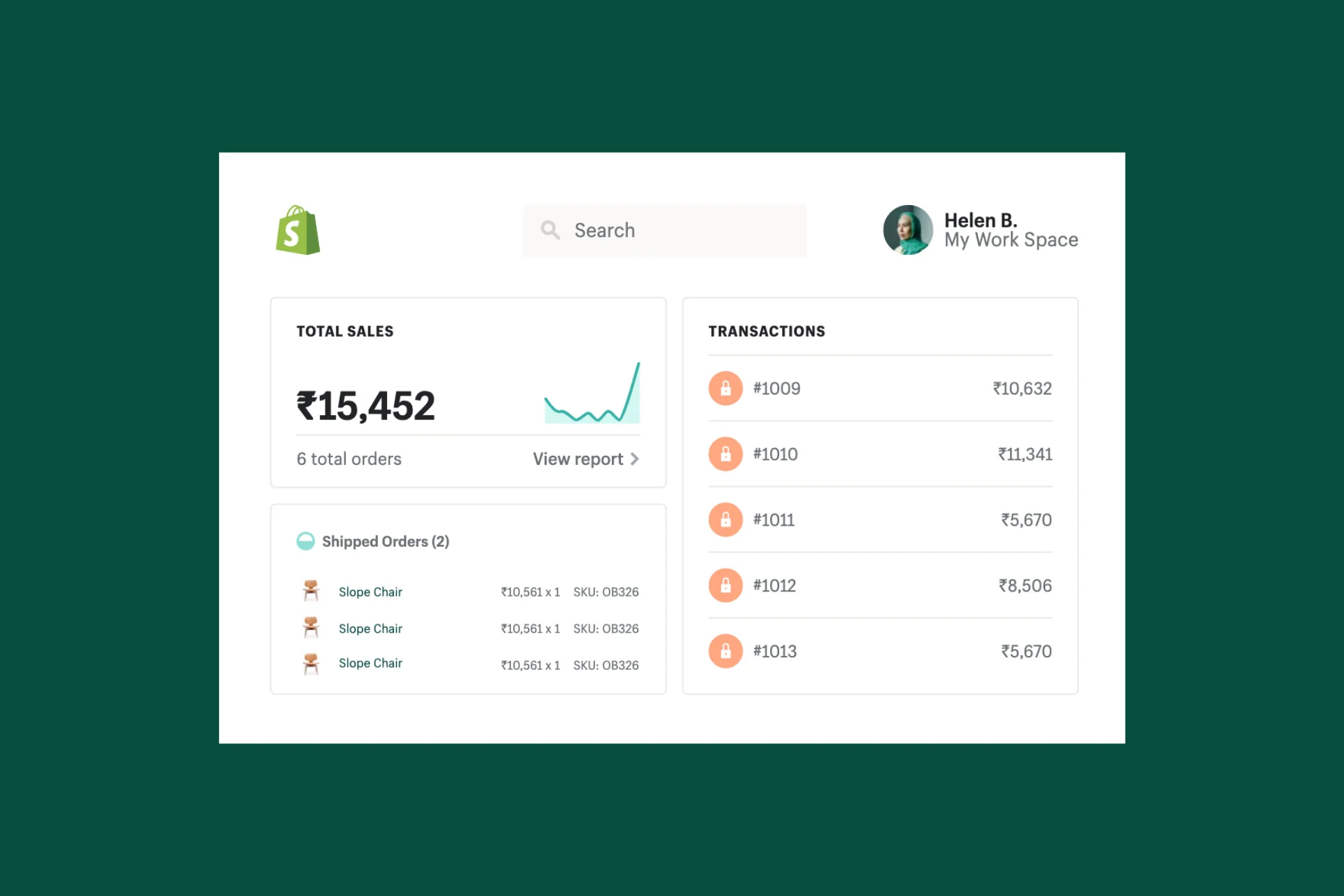
The ability to anticipate and adapt to emerging trends is what sets market leaders apart. As of 2024, the consumer world is being pivoted at an unprecedented rate, influenced by technological advancements, global socio-economic shifts, and a collective reevaluation of values and priorities post-pandemic. For brands, having an in-depth understanding of these emerging trends is crucial. Merely reacting to changes as they occur is no longer sufficient; foresight and strategic planning are deemed essential. These consumer behavior trends are not just a passing wave, they are powerful currents reshaping industries ranging from advertising, and agriculture to e-commerce, technology, and telecommunications.
1. Consumers have more control over spending.
The surge in living costs has prompted individuals to change their online spending habits, with 40% opting for methods that enable better tracking of expenditures.
According to Paysafe’s April 2022 survey with 11,000 consumers in 10 countries across Europe and the Americas, 21% plan to steer clear of credit purchases, potentially leading to reduced demand for buy now, pay later (BNPL) services.
Debit cards, credit cards, and digital wallets continue to dominate as preferred payment options:
- 59% prefer debit cards
- 51% opt for credit cards
- 33% utilize digital wallets
Retailers can adapt by providing diverse payment choices, including cash, as indicated by 47% of consumers who find it more convenient for online purchases. Embedded payments, a term denoting streamlined single-click payments, represent an overlooked opportunity for merchants, despite 49% of consumers being unfamiliar with the term. By creating a frictionless payment process, embedded payments offer consumers a more convenient, faster way to purchase, potentially boosting customer satisfaction and significantly improving conversion rates. Additionally, with the right provider, embedded payment methods like Shop Pay or Paypal are highly secure for both businesses and their customers. 38% of the online shoppers who use embedded payment perceive this technology to be more secure compared to conventional payment methods.
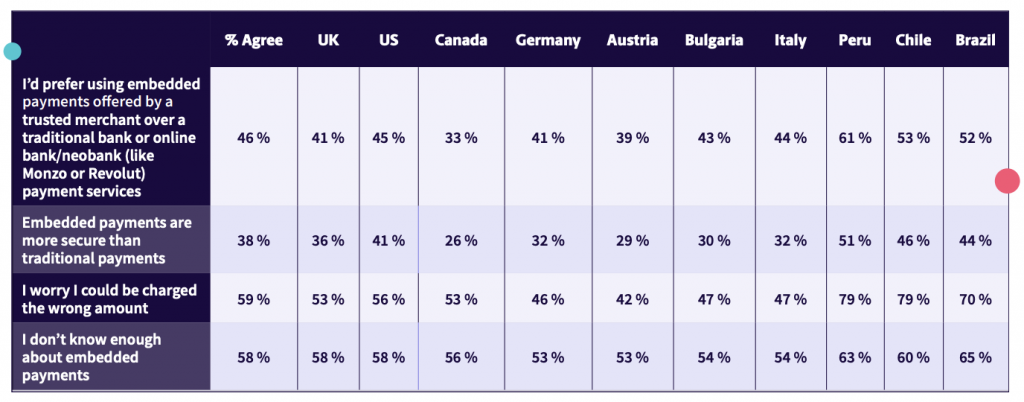
While consumer behavior continues to involve making purchases, they are more discerning about where they allocate their funds. It’s crucial to address their needs comprehensively by offering products that provide significant value. Highlight how the product effectively solves multiple problems and enhances consumers’ lives, fostering confidence and loyalty in the merchant brand.

2. The desire for personalization and customization is increasing.
Consumer behavior desire and anticipate personalized experiences across various platforms, through apps, websites, or physical stores. The payoff from personalization can be substantial for brands. This year, PetSmart surpassed the milestone of 60 million members, credited to its commitment to experimentation, innovation, testing, learning, and personalized engagement efforts, as highlighted by Bradley Breuer, VP of marketing, loyalty, personalization, and consumer relationship management.
This trend isn’t limited to the pet sector. Beauty retailers are also prioritizing consumer personalization and integrating technology into their strategies to cater to younger demographics who are tech-savvy. Research indicates that a significant portion of shoppers prefer AI-driven online shade matching for foundation over in-store testing. Moreover, the majority are more inclined to purchase products if they can utilize beauty tech to find the perfect shade or formula.
Beauty retailers have reaped the benefits of these personalized experiences. Estee Lauder’s virtual lipstick try-on, for instance, achieved a conversion rate 2.5 times higher among users of the AI tool. Similarly, Neutrogena’s collaboration with Nourish resulted in 3D-printed skin supplements, offering personalized skincare solutions based on a simple photo.
Data from Bolt further underscores the value consumers place on personalized online shopping experiences, with over half expressing willingness to pay a premium of 10% for beauty products accompanied by such personalized experiences.
3. While a significant number of consumers still prefer shopping in brick-and-mortar stores, online shopping remains dominant.
Despite the notable surge in e-commerce activity in recent years, many consumer behavior still prefer in-person shopping, particularly for high-value purchases.
According to a recent study conducted by Raydiant, there is an even split between shoppers who prefer in-store and online shopping, with approximately 45% of consumers favoring the in-store experience, and 55.6% consumers preferring purchasing online.
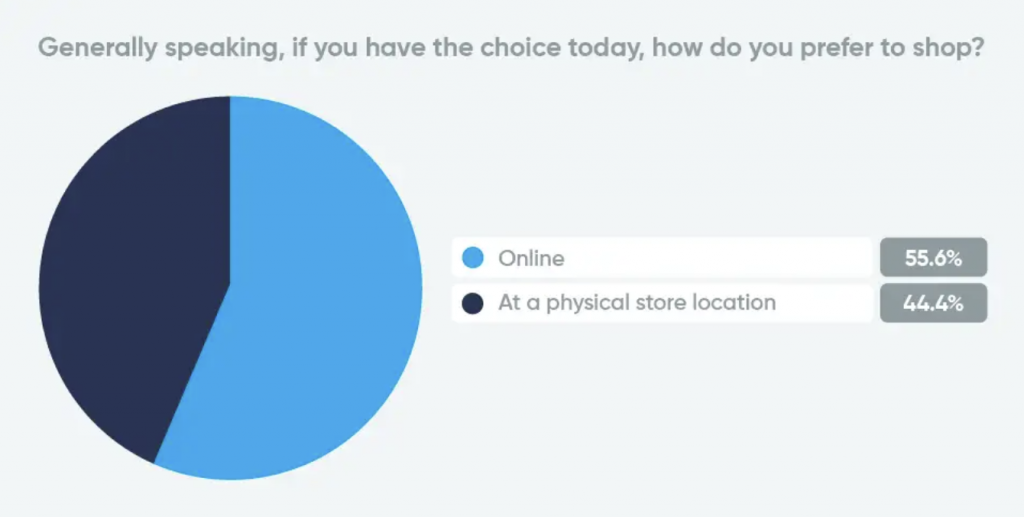
The study revealed:
- 27.6% of respondents cited the appeal of in-store experiences as their main reason for shopping in physical stores.
- 54.6% of respondents have stopped buying from a brand due to a single negative in-store experience.
- 31.9% of consumers believe that product selection and variety are the most important aspects of a positive in-store experience.
The number between the two types of purchases is quite close, but there are some main reasons why more consumer behavior prefer shopping online more than in-store:
- Online shopping is accessible around the clock (18.3%).
- The convenience of online shopping eliminates the need to go out (17.2%).
- Discount codes and various tools are easily accessible when shopping online (14.9%).
- Shopping online tends to be quicker than shopping in physical stores (10.5%).
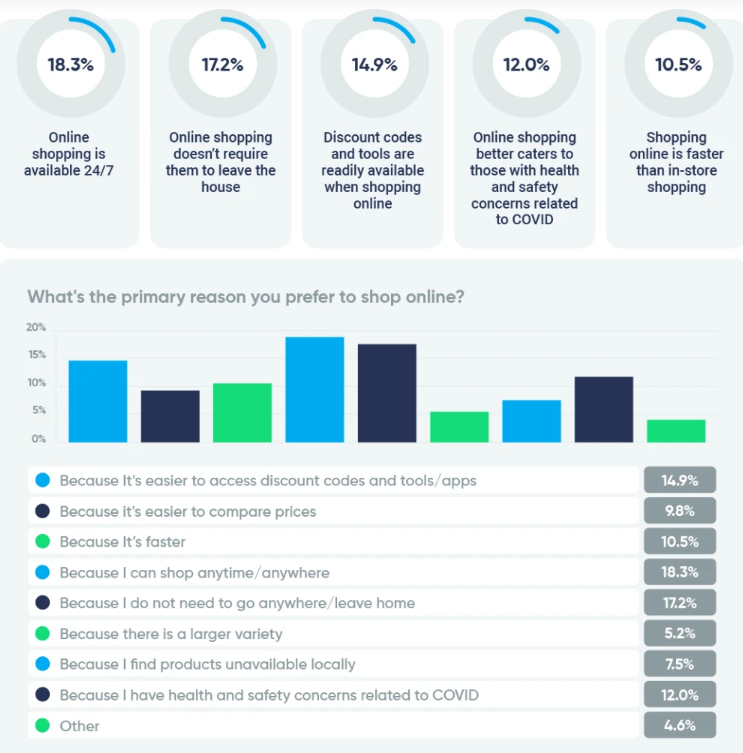
These findings align with the commonly known advantages of online shopping: it’s convenient, speedy, and straightforward. Particularly for individuals who aren’t in immediate need of a product and have limited time, online shopping can be highly attractive. However, for many consumers, these conveniences don’t necessarily translate to a superior shopping experience.
4. Free shipping & speedy delivery boosts consumer satisfaction.
According to Transport Topics, in 2017, e-commerce shipping demands witnessed a rise of 48% in just two years. Each day, numerous new e-commerce ventures emerge, and the viability of these businesses hinges on efficient shipping operations. Consequently, e-commerce shipping has evolved into a vital component of the online retail industry and shows no signs of slowing down.
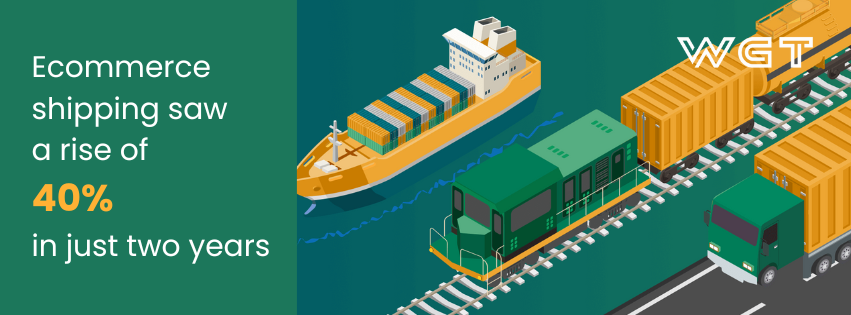
As reported by Inc. (2022), a significant 88% of consumers exhibit a stronger preference for e-commerce stores that offer free shipping. Many shoppers hesitate to proceed with their online purchases when confronted with shipping costs, often abandoning their shopping carts. Hence, e-commerce companies equipped with effective strategies and the resources to provide free shipping should seriously consider implementing it. This approach not only bolsters business prospects but also leads to heightened sales.
Reports also show that 87% of shoppers are open to buying from online retailers that offer free return shipping. Online consumers understand the potential uncertainties associated with their purchases, such as receiving items in the wrong size, color, or material, as well as the risk of goods being damaged during transit. Therefore, they often review an e-commerce platform’s return policy before making a purchase decision. Providing complimentary return shipping boosts consumer confidence by eliminating the concern of additional expenses should they need to return an item.
Marketing Profs (2022) found that 53% of consumers have canceled or abandoned their purchases due to delayed delivery, emphasizing the growing importance of fast delivery for online businesses. Thus, it is essential to communicate estimated arrival times to consumers and ensure timely delivery. Prioritizing fast order delivery is critical for enhancing consumer satisfaction and retaining customers who may otherwise seek quicker shipping options from competitors.
5. Privacy and data security become more important in the purchase process.
With the widespread use of e-commerce platforms and digital payment methods, consumers are entrusting their personal information to businesses more than ever before. As a result, they expect companies to handle their data with utmost care and ensure its protection from unauthorized access or misuse.
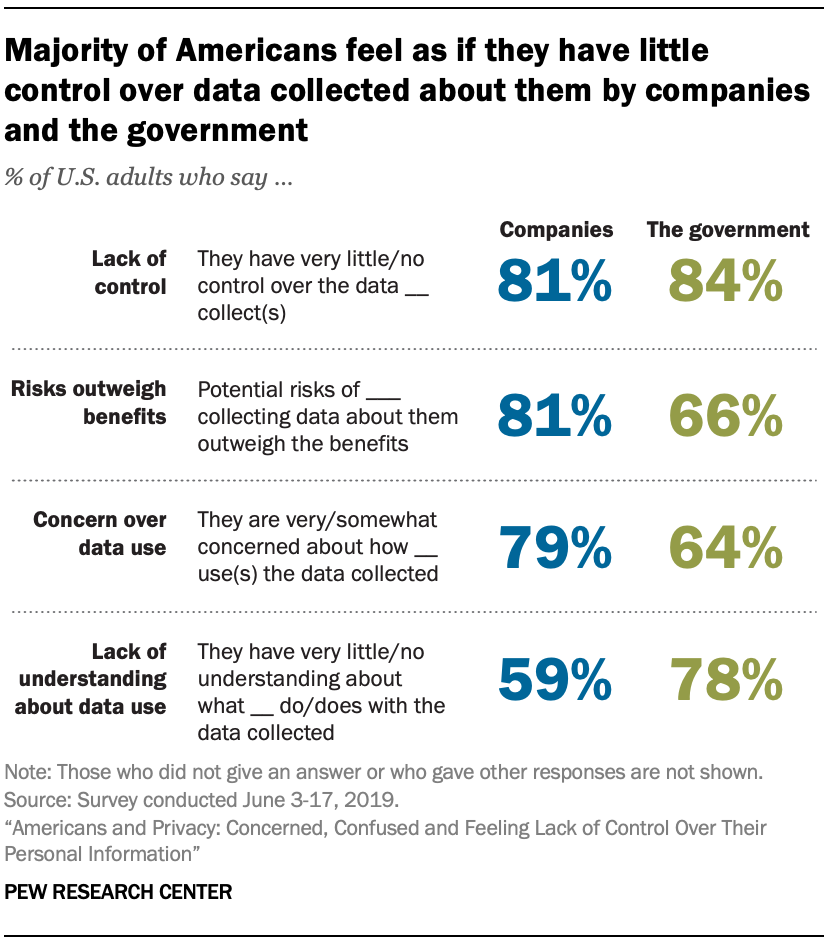
72% of Americans express the belief that advertisers, technology firms, or other companies track all, or almost all of their online activities or cellphone usage. Another 19% believe that some of their online behavior is monitored. Additionally, nearly half (47%) of adults are of the opinion that the government tracks most of their online activities.
Regarding their offline behavior such as their location or social interactions, 69% of respondents believe that companies monitor at least some of these activities. Furthermore, 56% of Americans suspect that the government tracks some aspects of their offline behavior, such as their conversations or whereabouts.
Driven by increasing consumer awareness of data breaches and cyber threats, privacy and data security have become crucial in the purchase process. High-profile incidents have made individuals cautious about sharing personal data online, with 79% of adults expressing concern about how companies utilize collected data. Additionally, regulations such as GDPR and CCPA require transparency and consent for data collection, with non-compliance resulting in significant fines.
To address these affairs, businesses are investing in encryption, authentication methods, and transparency regarding data practices. However, there’s still widespread about government data collection, with 64% of consumers expressing similar levels of worry. While social media sites and advertisers raise significant worries, few are worried about what family, friends, or employers might know.
6. Consumers are more likely to buy stuff repeatedly.
Subscription-based businesses have thrived across multiple sectors, with notable success seen in industries such as beauty and food. According to Recharge’s The State of Subscription Commerce 2022 report, the combined subscriber pool for beauty and personal care, as well as food and beverage, accounted for 54% of subscribers in 2021.
Additional popular categories for subscription services encompass home goods, fashion, apparel, and pets. Despite being in its early stages, the subscription economy is expanding swiftly. Between 2020 and 2021, the health and wellness sector experienced the most substantial growth in monthly recurring revenue (MRR), with merchants witnessing a surge of over 138% in MRR. Similarly, businesses in the pets and animals category observed an average MRR increase of 107% during the same timeframe.
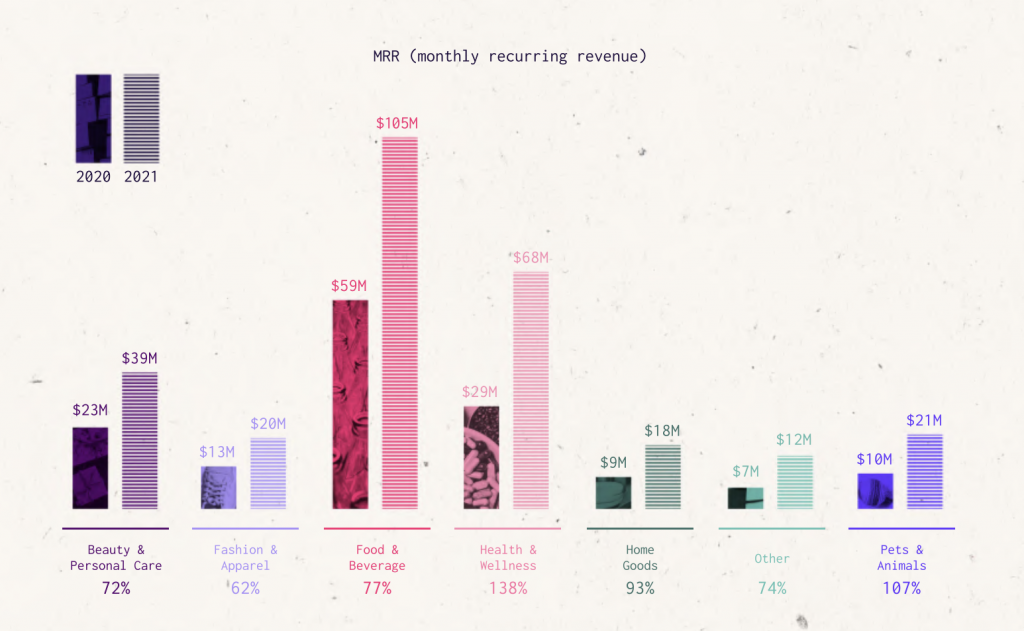
7. Concerns over inflation and rising prices arise.
Rising inflation and significant price hikes on essential goods are causing considerable worry among shoppers. As their purchasing power diminishes, 81% of consumers are adjusting their shopping habits to better manage their expenses, with an increasing number (42%) adopting a cautious approach to spending despite not facing direct financial impacts. A recent NielsenIQ report reveals growing concerns among consumers regarding a looming recession, leading to a heightened sense of financial insecurity compared to six months ago:
- 52% express reduced confidence in economic stability.
- 29% feel less assured about meeting their daily expenses.
- 25% are uncertain about the stability of their household income.
To cope with these uncertainties, US consumers are scaling back on discretionary spending, including travel and dining out, in favor of prioritizing essential purchases such as groceries.
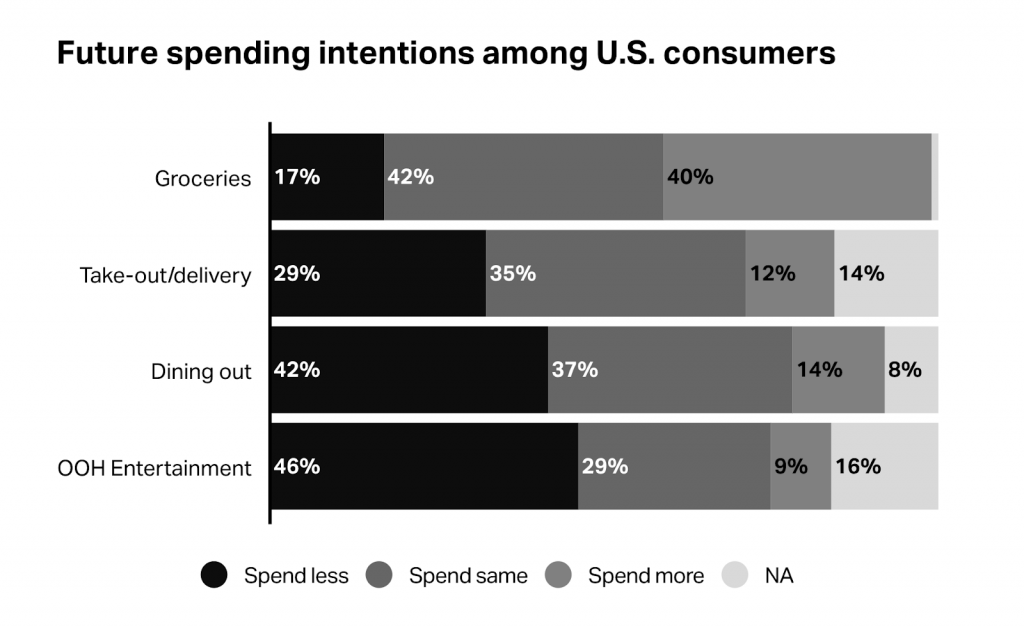
8. The purchase behavior of consumers in 2024 is influenced by the mobile commerce revolution.
According to a survey conducted by 1WorldSync Data, a significant proportion of consumer behavior, 87%, utilized their smartphones to research products while in-store. Consequently, 66% of shoppers transitioned their purchase behavior from browsing in-store to making purchases online in the last two months. This insight comes from a study by Sinch on consumer behavior during and post-pandemic.
Furthermore, the emergence and spread of mobile applications (apps) have been facilitated by the massive use of mobile devices, significantly influencing consumer behavior and habits. It’s likely that a mobile app is used to organize and remind of grocery shopping. Perhaps an application from one of your favorite brands, which sends real-time information on their offers and new products, has been downloaded. It’s also probable that an app to manage and organize the next trip has been downloaded (buying tickets, hotel reservations, tourist guides, etc.).
Simply put, the rules of the game have been changed by the Internet. Due to ubiquitous mobile devices, consumer behavior has shifted and continues to change. In the very near future, common and recurrent behaviors today will become an oddity, or simply disappear. There is no doubt that retailers will need to change and adapt accordingly, even more so than other industries.
According to certain studies, such as one prepared by IBM and referred to by Computer World, stores will become mere showrooms in 10 years so that customers, as part of their shopping experience, can physically see, touch, and test products, which will be bought online afterward for home delivery. In this new operational model, real-time information will be required by retailers, as well as in-store technology to allow any ordering process. Furthermore, free and fast shipping will be offered by them to compete effectively with the convenience of in-store buying from stock.
9. Demand for sustainable products is increasing.
As consumer behavior trends towards greater conscientiousness, the significance of sustainable products in purchasing decisions is on the rise. According to research conducted by IBM, 77% of consumers view sustainability and environmental responsibility as at least “moderately important” brand values.
Additionally, Harvard Business Review notes that sustainable products experience 5.6 times higher average sales growth compared to those not marketed as sustainable. While pioneering companies like Patagonia and Levi’s have led the way in sustainability, Gen Z consumers are now spearheading the conversation.
However, a recent report from First Insight and the Baker Retailing Center at the Wharton School of the University of Pennsylvania highlights that many senior retail executives have a limited understanding of consumers’ preferences regarding sustainable offerings and shopping habits. The report additionally discovered that:
- A majority of consumers across all age groups are willing to spend extra on sustainable products.
- Nearly half of consumers prioritize product sustainability over brand name recognition.
- A significant percentage of consumers express that sustainability holds some degree of importance to them.
The impact of Gen Z will continue to grow as younger members transition into adulthood. According to Insider, by 2030, Gen Z is projected to account for 27% of global income, surpassing millennials by 2031.
10. A greater number of monthly services tend to be subscribed to by consumers.
The report by market research firm C+R Research, consumer behavior regarding their monthly spending on subscriptions yielded an average estimate of $86. However, upon delving into specific subscription categories, the actual average expenditure was found to be $219 – reflecting a $133 increase from their initial estimate.

In other industries, such as video games, purchases were typically made as single transactions. The desired game would be identified, purchased for a fixed price, and then enjoyed with unlimited gameplay thereafter. This purchasing model largely remains unchanged. However, subscription-based gaming services are being introduced by major players in the gaming industry, such as Sony and Microsoft. For instance, Sony’s PS Now service offers streaming access to hundreds of titles for a monthly subscription fee. This service has rapidly attracted over 3.2 million subscribers.
11. Instead of recognizing the power of AI when making purchases, consumers are skeptical.
A recent survey conducted by Builtin involving 2,000 consumers, revealedhat 85% of shoppers expressed no interest in utilizing AI to assist in their purchasing decisions. Additionally, 60% stated that AI recommendations would have no impact on their shopping choices. At first glance, consumers appear to perceive minimal value in AI when making online purchases. There are 3 main reasons why consumers don’t trust AI for shopping:
- Data privacy concerns: AI represents a more significant data privacy intrusion than social media-collected data for marketing.
- Ineffective marketing channels: AI is being employed to address ineffective marketing channel strategies. A cohesive marketing approach holds greater importance compared to AI recommendations.
- Bad recommendations: Insufficient data results in the majority of AI recommendations lacking accuracy, which causes users to question the validity of AI-generated suggestions.
12. Conclusion
In conclusion, the anticipated consumer behavior trends for 2024 present a dynamic landscape shaped by evolving preferences and emerging priorities. From the growing emphasis on sustainability and personalized experiences to the continued importance of in-person shopping for certain segments, these trends underscore the need for businesses to adapt and innovate in response to changing consumer demands. By staying attuned to these shifts and leveraging insights to inform strategies, companies can position themselves to thrive in an increasingly competitive marketplace.
Stay in the loop with the latest updates on E-commerce platforms by subscribing us!






